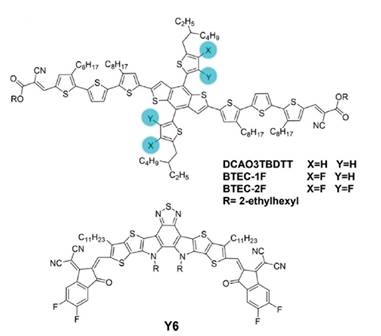
A research group led by Prof. GE Ziyi at the Ningbo Institute of Materials Technology and Engineering (NIMTE) of the Chinese Academy of Sciences (CAS) has developed a BTEC-2F-based non-fullerene all-small-molecule organic solar cells (NFSM-OSCs) with a power conversion efficiency (PCE) of 13.34%, which is among the highest PCE reported for NFSM-OSCs. The study was published in Angewandte Chemie International Edition.
As a new type of renewable energy applications, organic solar cells (OSCs), have attracted extensive attention by virtue of their unique merits of low cost, lightweight, mechanical flexibility and large-area fabrication. NFSM-OSCs comprise small molecular donors and non-fullerene acceptors, showing great potential due to their definite chemical structure, high purity and good reproducibility. However, challenges in the fine tuning of phase separation morphology have limited the PCE of NFSM-OSCs.
To break this bottleneck, the researchers designed and synthesized two novel small molecular donors, BTEC-1F and BTEC-2F, which were derived from the small molecule DCAO3TBDTT. Through the fluorination of the small molecular donors, they successfully regulated the crystallization and orientation of the active layer.
Compared to the non-fluorinated DCAO3TBDTT, the mono-fluorinated BTEC-1F-based NFSM-OSC showed an improved open circuit voltage (Voc) of 0.870 V and a PCE of 11.33%. In addition, the fill factor (FF) of difluorinated BTEC-2F-based NFSM-OSC was distinctly improved to 72.35%, yielding a PCE of 13.34%, which is among the highest PCE for NFSM-OSCs reported to date.
The excellent photovoltaic performances of BTEC-2F:Y6 based OSCs could be attributed to the more compact molecular stacking and lower crystallinity of BTEC-2F, which enhanced phase separation and carrier transport.
The study revealed an efficient method for NFSM-OSC fabrication, and shed light on the rational design criterion of high-performance NFSM-OSCs.

Chemical structures of DCAO3TBDTT, BTEC-1F, BTEC-2F, and Y6, respectively. (Image by NIMTE)

86-10-68597521 (day)
86-10-68597289 (night)

52 Sanlihe Rd., Xicheng District,
Beijing, China (100864)

